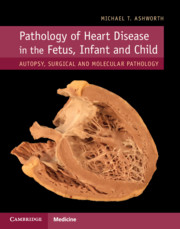Book contents
- Pathology of Heart Disease in the Fetus, Infant and Child
- Pathology of Heart Disease in the Fetus, Infant and Child
- Copyright page
- Dedication
- Contents
- Preface
- Chapter 1 The Anatomy of the Normal Heart
- Chapter 2 Examination of the Heart
- Chapter 3 Development of the Heart
- Chapter 4 Congenital Heart Disease (I)
- Chapter 5 Congenital Heart Disease (II)
- Chapter 6 Ischaemia and Infarction
- Chapter 7 Cardiomyopathy
- Chapter 8 Inflammation of the Myocardium, Endocardium and Aorta
- Chapter 9 The Coronary Arteries
- Chapter 10 Metabolic and Storage Disease
- Chapter 11 Pericardium
- Chapter 12 Fetal Cardiovascular Disease
- Chapter 13 Tumours
- Chapter 14 Heart Transplantation
- Chapter 15 Sudden Cardiac Death in the Young
- Index
- References
Chapter 3 - Development of the Heart
Published online by Cambridge University Press: 19 August 2019
- Pathology of Heart Disease in the Fetus, Infant and Child
- Pathology of Heart Disease in the Fetus, Infant and Child
- Copyright page
- Dedication
- Contents
- Preface
- Chapter 1 The Anatomy of the Normal Heart
- Chapter 2 Examination of the Heart
- Chapter 3 Development of the Heart
- Chapter 4 Congenital Heart Disease (I)
- Chapter 5 Congenital Heart Disease (II)
- Chapter 6 Ischaemia and Infarction
- Chapter 7 Cardiomyopathy
- Chapter 8 Inflammation of the Myocardium, Endocardium and Aorta
- Chapter 9 The Coronary Arteries
- Chapter 10 Metabolic and Storage Disease
- Chapter 11 Pericardium
- Chapter 12 Fetal Cardiovascular Disease
- Chapter 13 Tumours
- Chapter 14 Heart Transplantation
- Chapter 15 Sudden Cardiac Death in the Young
- Index
- References
Summary
A brief account of early embryo formation is followed by an overview of the salient features of heart development. Following this there is a detailed treatment of the processes involved in the construction of the functioning embryonic heart, including a focus on the genes involved. Short sections are devoted to pericardium, coronary arteries and conduction system, the systemic veins and the systemic arteries. Finally, the fetal circulation and its adaptation to post-natal life are described.
Keywords
- Type
- Chapter
- Information
- Pathology of Heart Disease in the Fetus, Infant and ChildAutopsy, Surgical and Molecular Pathology, pp. 53 - 74Publisher: Cambridge University PressPrint publication year: 2019

